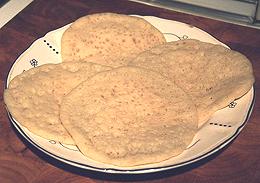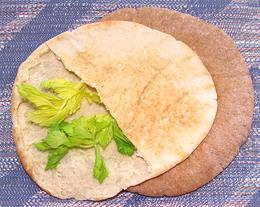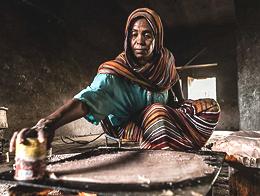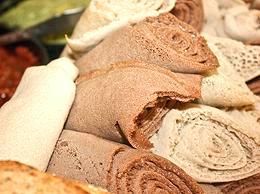
SAFARI
Users
North Africa
- The Maghreb (Algeria, Morocco, Tunisia, Libya, Mauritania), Egypt, SudanBaghrir
- [Beghrir] This is a popular bread in the Maghreb region, often eaten for
breakfast with a mix of butter and honey, but also with jams. It is
made from semolina or wheat flour.
Photo by Tamorlan distributed under license Creative Commons
Attribution-ShareAlike v3.0 Unported.
This is a popular bread in the Maghreb region, often eaten for
breakfast with a mix of butter and honey, but also with jams. It is
made from semolina or wheat flour.
Photo by Tamorlan distributed under license Creative Commons
Attribution-ShareAlike v3.0 Unported.
Pita Bread
- [Pita (Greek); Pocket Bread; Pide (Turkey); Khubz Arabi (Arabic)]
This lightly leavened wheat bread is very popular throughout North Africa, and far beyond. The ethnic markets here in the Los Angeles region are piled high with pita, in both white (photo) and whole wheat versions, in the 7 inch and larger sizes.
The earliest Arabic recipes (10th century) have these baked in a Tandoor, but today they are usually made in continuous industrial ovens so as to meet the high demand. Pita is baked in a very hot oven at 450°F/232°C or higher, causing the disk to puff up dramatically. When removed from the oven the disk collapses, but the two sides remain separated, so the bread can be opened into a pocket. Throughout the region, street foods of all kinds are packed into pita pockets.
The photo specimen was a 7 inch diameter disk 0.15 inch thick. Half
the top layer was removed to show the inside. Enriched wheat flour,
water, yeast, salt, calcium propionate.
Kisra Rhaheeefa
 Kisra Rhaheeefa is much like Ethiopia's Injera
and used similarly, but is made from Sorghum Flour or Wheat Flour rather
than Teff. The "Kisra Rhaheeefa" name differentiates it from "Kisra
Aseeda", which is a Sorghum Porridge.
Photo by Mohammed Elfatih Hamadien distributed under
license Creative Commons
Attribution-ShareAlike v4.0 International.
Kisra Rhaheeefa is much like Ethiopia's Injera
and used similarly, but is made from Sorghum Flour or Wheat Flour rather
than Teff. The "Kisra Rhaheeefa" name differentiates it from "Kisra
Aseeda", which is a Sorghum Porridge.
Photo by Mohammed Elfatih Hamadien distributed under
license Creative Commons
Attribution-ShareAlike v4.0 International.
The Horn of Africa
- Ethiopia, Djibouti, Eritrea, SomaliaInjera
- [Injera (Amharic); (Bidenaa (Oromo)]
This is the bread of Ethiopia and Eritrea, usually made from Teff. It was traditionally, and is often still today, made very large, to fit the table for which it would be the tablecloth. Scoops of stews and other recipes are placed directly on it. Diners tear off pieces of the "tablecloth" and use them to pick up the food. Today, especially in restaurants it is often made smaller and served on an Indian thali, or a very large plate. Photo by PhoTom distributed under license Creative Commons Attribution-ShareAlike v4.0 International.
This is a sour dough bread, made with a leavened batter similar to
thin pancake batter. The batter is baked on a large clay or metal tray,
over moderate heat, and on one side only. Bubbles on the top side burst,
giving the bread a spongy texture, almost like honeycomb tripe, which
is very good at holding sauces. Temperature is regulated so it sets
through, but does not brown on the bottom (see the rolled examples in
the photo at the top of the page). It can be made using white or brown
Teff, or a mix. Farmers say the white Teff is preferred to the brown by
most of their customers.
Lahoh
- [Luhuh (Somali), Laxoox, Lahooh, Canjeero, Canjeelo, Anjeero]
This bread is popular in Somalia, Djibouti and Yemen, but now also
popular in Israel, introduced by Yemenite Jews. It is a fermented sour
dough bread usually made of Sorghum Flour or Corn Flour and cooked on
circular metal stove called a taawa or daawo. In Yemen, it is often
served by street vendors.
Photo by Gilabrand at en.wikipedia distributed under
license Creative Commons
Attribution-ShareAlike v3.0 Unported attribution required.
East Africa
- Tanzania, Kenya, Uganda, Rwanda, Burundi and South SudanChapati
 Long influenced by India, East Africa has adopted the Indian Chapati as
their main form of bread - but they use white flour instead of the whole
wheat Atta flour used in India. As it is very inconvenient for me
to produce Chipatis, I use Flour Tortillas, easily available here in
Southern California. I prefer the small 5 inch diameter ones.
Incidentally, Whole Wheat Flour Tortillas make an excellent substitute
for Indian Chapatis
Long influenced by India, East Africa has adopted the Indian Chapati as
their main form of bread - but they use white flour instead of the whole
wheat Atta flour used in India. As it is very inconvenient for me
to produce Chipatis, I use Flour Tortillas, easily available here in
Southern California. I prefer the small 5 inch diameter ones.
Incidentally, Whole Wheat Flour Tortillas make an excellent substitute
for Indian Chapatis
Kisra Rhaheeefa
 South Sudan (Christian and Native Religion) is now a separate country
from Sudan (all Muslim) and is moving strongly into the East African
community. One thing they still have in common with Sudan is Sudan's
Kisra Rhaheeefa.
South Sudan (Christian and Native Religion) is now a separate country
from Sudan (all Muslim) and is moving strongly into the East African
community. One thing they still have in common with Sudan is Sudan's
Kisra Rhaheeefa.


